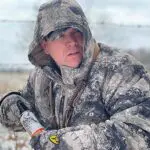While sitting in the truck’s cab taking a break between coyote calling stands, our outfitter shared some of his secrets about their massive turkey flock and how they achieved success each spring.
In the red dirt of Oklahoma, the Rio Grande turkeys roamed near the cattle fields like ants crawling on an ant hill. Our guide explained where the hundreds of turkeys roosted each night, how they approached those areas when hunting, and different calling and decoy techniques that worked well when hunting the vast flocks. The guide had my full attention when he began talking about “the roost tree” and how there would be over a hundred turkeys in one tree every night. Trying not to let my excitement overtake my composure was difficult as this small-town country boy from southern Missouri had never seen so many turkeys in all my life. Even though we were on a coyote hunt, I was ready to trade my electronic caller for a turkey call.
My first attention grabber was how they had a name for where the turkeys roosted. “The roost tree” was the one tree where most turkeys roosted each evening. It seemed a no-brainer that the area that turkey hunters needed to be hunting was as close to the “roost tree” as possible, or so I assumed. Unfortunately, as we sat in the truck, listening in awe, the guide explained that none of his hunting clients were allowed within hundreds of yards of that tree. He then stated that having no hunting pressure near the roosting area kept all the turkeys on easier-to-pattern travel routes and, in turn, made hunting much easier for their entire property.
As most turkey hunters know, a place with hundreds of turkeys in one specific area and a roosting area with over a hundred turkeys a night is rare and unique. Even though most turkeys I hunt each spring are in much smaller flocks, I have adapted our Oklahoma guide philosophy of being cautious around roosting areas to improve overall hunting.
What Is Roosting A Turkey & How To Put a Turkey To Sleep
One of the most effective tips from veteran turkey hunters is to learn how to roost turkeys the night before hunting. “Roosting” refers to finding an area where turkeys fly up in a tree to sleep. Once an area has been sought, use that information to plan a successful hunting approach to get into close range as quickly as possible after the bird flies down the following morning.
The term “put a turkey to sleep” is often used by turkey hunters and refers to locating a gobbler moments before he flies up to the roost. Because the hunter knows where the gobbler is roosting, they can quietly ease back into the area the next morning to be in a better position to attempt to call him into close range.
When locating a tom headed to roost, the hunter should use the same locator calls used in the mornings. An owl, crow, or coyote call works great for creating a shock gobble from a nearby tom. By creating one of these natural sounds, a tom will respond by gobbling, which gives up his location to hunters. If the hunter waits until moments after the sun has set before locating, they can get a better-designated area where the tom is roosted. It is common to hear the turkey’s wings beating when flying up if one can be patient and sit quietly after locating a tom. Once the roost area has been established, the hunter should stay put until after complete darkness to avoid spooking the tom off the roost. Ease out quietly and return early the next day.

How to Hunt Near The Roost
When roosting turkeys, whether one hundred in one tree or two toms in the same area, approaching the roost site must be done cautiously. First, it is vital to re-visit the roosted area from the night before, well before daylight. The goal is to get as close to the roost tree as possible without spooking the turkeys. If one can get closer than a hundred yards yet no closer than fifty, the chance of being in the proper position to call them into shooting range is much better. Next, the hunter should keep calling to a minimum and keep a lower volume to avoid spooking close-by toms out of the area. When a hen first wakes up while still on the roost limb, she makes soft yelps, often called a tree call. When trying to imitate that sound early in the morning, make two or three soft yelps, go silent for a few minutes, and repeat three calls. Making the soft yelps lets the roosted tom know that a hen is roosting close and waiting for him to fly down so they can meet up.
To keep the roosted tom curious and eager to come to the call, keep all calls soft, few, and far between until there is the sound of the tom flying down from the roost. After the gobbler fly’s down, proceed by ramping up calling by making the fly-down cackle or a more excited hen yelp. These sounds simulate a hen who has flown down from the roost and is eager for a gobbler’s company, which creates the perfect amount of urgency for the tom to waste no time coming to the call.



